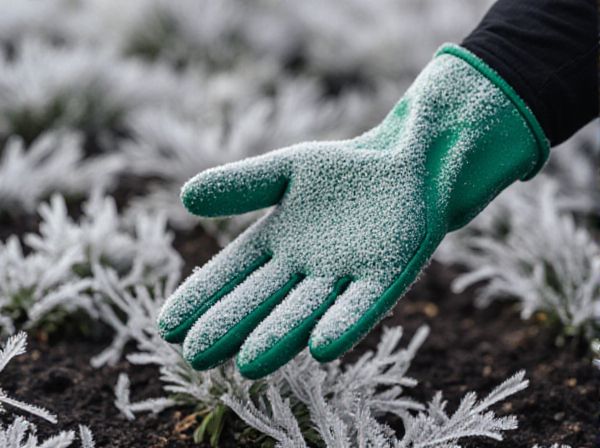
First frost vs Last frost Illustration
The first frost signals the end of the growing season, often marking the onset of colder temperatures that can damage or kill tender plants. In contrast, the last frost usually occurs in early spring and indicates the safe time for planting frost-sensitive crops. Understanding the timing of both first and last frosts is crucial for gardeners and farmers to optimize planting schedules and protect their crops.
Table of Comparison
| Frost Type | Definition | Typical Timing | Significance | Impact on Plants |
|---|---|---|---|---|
| First Frost | The first occurrence of frost in autumn/winter | Late September to November (varies by region) | Marks the beginning of colder season and end of growing season | Can damage or kill frost-sensitive plants; signals time to harvest |
| Last Frost | The final frost occurrence in late winter/early spring | March to May (depends on climate zone) | Signals start of growing season and planting of sensitive crops | End of frost risk for seedlings and young plants |
Understanding First Frost and Last Frost Dates
First frost marks the initial occurrence of freezing temperatures in a region, signaling the end of the growing season and the onset of colder weather. Last frost refers to the final freeze event in spring, indicating when it is generally safe to plant frost-sensitive crops outdoors. Accurately understanding first and last frost dates is crucial for farmers and gardeners to protect plants from frost damage and optimize planting schedules.
The Science Behind Frost Formation
Frost forms when surface temperatures drop below the freezing point of water (0degC or 32degF), causing moisture in the air to crystallize directly on surfaces. The first frost of the season typically occurs when nighttime temperatures consistently reach this threshold after a period of cooling, signaling the onset of colder weather. Conversely, the last frost marks the final occurrence of freezing temperatures in spring, crucial for agricultural planning as it defines the safe planting window for frost-sensitive crops.
How to Find Your Local Frost Dates
To find your local first and last frost dates, use resources like the National Oceanic and Atmospheric Administration (NOAA) frost date maps or the USDA Plant Hardiness Zone Map, which provide region-specific frost data based on historical climate records. Gardening websites and local agricultural extension offices often offer frost date calculators tailored to your ZIP code or coordinates, allowing precise planting schedules. Tracking these dates helps optimize seed starting and frost protection strategies, ensuring healthier plant growth in your specific climate zone.
Impact of Frost on Garden Plants
First frost typically causes the initial damage to sensitive garden plants by freezing the water inside their cells, leading to tissue rupture and potential plant death. Last frost marks the end of the frost season, signaling gardeners to safely plant frost-sensitive crops without risk of cold damage. Understanding the timing and impact of both first and last frost is crucial for optimizing planting schedules and protecting garden plants from frost-related stress.
Planning Your Garden Around Frost Dates
First frost marks the initial occurrence of freezing temperatures in autumn, signaling the end of the growing season and the need to harvest frost-sensitive crops promptly. Last frost refers to the final spring freeze that determines the safe planting date for frost-sensitive plants, ensuring seedlings are not damaged by unexpected cold. Understanding local first and last frost dates enables gardeners to plan planting schedules accurately, select suitable crops, and protect vulnerable plants, optimizing yield and garden health.
Protecting Plants from Unexpected Frosts
First frost marks the initial temperature drop that causes frost formation in a season, signaling a critical time to protect sensitive plants. Last frost indicates the final occurrence of frost in spring, after which tender plants can be safely planted outdoors. Implementing frost protection techniques such as covering plants, using frost cloths, or applying mulch can prevent damage caused by these unexpected temperature drops.
Seed Starting: Timing with Frost Dates
The first frost date marks the end of the growing season and signals when outdoor seed starting should be completed to avoid frost damage, while the last frost date indicates when it is safe to transplant seedlings outdoors. Monitoring these frost dates allows gardeners to optimize seed starting timing, ensuring seeds germinate in warm soil and young plants thrive without exposure to cold stress. Accurate local frost date data enhances planning for seed starting schedules, maximizing plant survival and yield.
Extending Your Growing Season Beyond Frost
Understanding the timing of the first frost in autumn and the last frost in spring is crucial for extending the growing season. Protecting plants with row covers, cold frames, or mulch can help mitigate frost damage and prolong harvesting periods. Gardeners can also select frost-resistant crops or start seedlings indoors to maximize productivity before the frost dates.
Common Mistakes with First and Last Frost
Common mistakes with first and last frost dates include relying solely on calendar dates instead of local climate data, which can lead to premature planting or protection measures. Gardeners often confuse the first frost with the last frost, resulting in either unexpected crop damage or delayed planting schedules. Misinterpreting frost data without considering microclimates and historical weather patterns disrupts seasonal planning accuracy.
Resources for Tracking Frost Dates
Accurate tracking of first and last frost dates is essential for effective gardening and agricultural planning, with resources such as the USDA Plant Hardiness Zone Map offering region-specific frost forecasts. Online databases like the National Oceanic and Atmospheric Administration (NOAA) provide historical frost data, enabling gardeners to predict frost risk periods based on climate trends. Mobile apps and local extension services also deliver real-time temperature alerts and frost advisories to safeguard plants from unexpected freezes.
First frost vs Last frost Infographic

 gardendif.com
gardendif.com